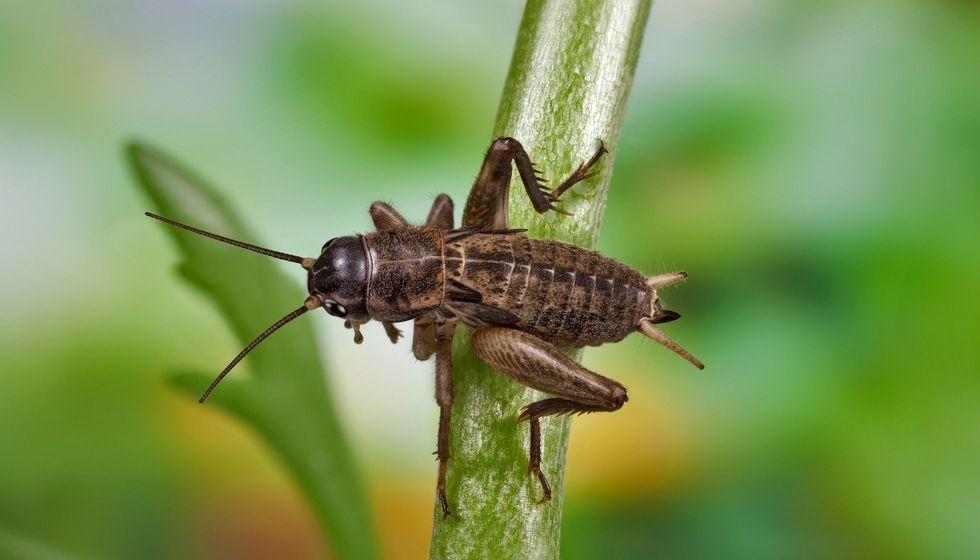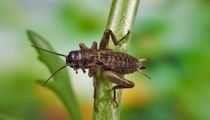Crickets are small to medium-sized insects, part of the Grylloidea family, and are well-known for their musical chirping.
The word cricket comes from the French word ‘criquer,’ which means small creaker. At some time, most of us might have experienced the cricket's chirping sound on a warm summer night.
Crickets have a long cylindrical body with a round head and long thin antennae. Their body length varies between 0.12-2 in (3-50 mm) and belongs to the order Orthoptera, which is more distantly related to grasshoppers and katydids. The largest species of crickets is Brachytrupes, which grows up to 2 in (5 cm) long.
There are around 900 species distributed worldwide, excluding cold regions at latitudes elevated above 55° north and south. Crickets occur in varied habitats like forests, grasslands, bushes, upper tree canopies, marshes, herbs, caves, rotting wood, and beaches.
Crickets are swift and fancy flier; however, many species are flightless. These insects are best known for their loud and persistent chirping sound, but not all species chirp. They use a process called stridulation, where generally only male crickets make the sound. They rub their specially structured front wings together called scrapers to make a noise.
In ancient China and Japan, crickets were considered to be symbols of good luck and respect. They were kept in gold cages so that people could listen to their harmonious chirping. Isn't that interesting? Let's dive in to find out more fun facts about crickets and their song.
If you like reading this article, then browse through our other interesting articles like why do woodpeckers peck wood? And how to avoid woodpecker's pecking? And why do birds sing?
Why do crickets chirp at night?
Crickets mainly use their chirping sound as an essential part of their communication apart from other methods like scent and touch. They use their wings to produce these chirping sounds.
Not all crickets can chirp. Females do not chirp, and only male crickets can produce this sound depending on their species. When a cricket chirps, it might be for reasons like mating, searching for food, or a warning call.
Male cricket's wings have grooved sides on their fore wings, which produce this sound when rubbed against each other. This rubbing process is called stridulation.
We usually hear this chirping sound at night because crickets are mainly nocturnal. Male crickets primarily use their unique chirping as a mating song for wooing female crickets. They compete with other males and make loud chirps to create a calling song to attract females, this helps the females locate the male cricket.
Once the female approaches the male, it is followed by a softer courtship song for mating. Additionally, the male will sing another song as a unique chirp of triumph to keep the female away from other males.
Crickets also use songs as territorial warnings to other males to leave their territory. The males use an aggressive tone, and chirping frequency that is different from the mating sounds to ward off the intruder.
They also use songs to establish dominance by being protective of their mated females. If any male tries to attract an already mated female with songs in their territory, the mated male will use a special rivalry call to encourage its competitor to back off. This is usually known as satellite behavior.
Why do crickets chirp during the day?
In a cricket's life cycle, chirping is a vital activity. Most cricket species are primarily nocturnal and sing at night, while occasionally, we can hear their chirping during the day. However, their noise is much less frequent in the daytime.
Despite mating and territorial songs, crickets chirp for distracting predators during the day. When male crickets are singing songs searching for a mate, it also often catches predators' attention, like the Tachinid fly and the Parasitoid fly.
This Parasitoid fly listens for cricket sounds and lays her eggs on them. It will hatch eggs into larvae by feeding on the cricket, and consequently, the cricket dies within a week.
Crickets also use several methods while dealing with predators. At night, they chirp as if the sound is coming from somewhere else and distract their predators.
Sometimes they also fall silent when they sense danger nearby. There is a myth that cricket's chirp is produced by rubbing their legs together, but in fact, male crickets make this sound using their wings.
Different cricket species have distinctive noise-making patterns and pulse rates that produce unique sounds. The most common way scientists distinguish them is by the sound they make.
A cricket's chirp is over 100 dB, equal to a car's horn, about 110 dB. For example, Field crickets (Gryllus bimaculatus) chirping calls can reach 100 dB, while the Mole cricket (Gryllotalpa vineae) chirps at about 88 dB.
Why do male crickets chirp?

On a calm night, especially if you live in areas with bushes, you can hear the sounds of cricket chirps. This sound you hear is the sound of crickets singing. Crickets are the major singing animals at night in summer and they prefer to perform their repertoire after the sunset.
Male crickets chirp to discover female mates. They have delicate hindwings and tough leathery forewings called tegmen that cover the delicate hindwings when folded at rest. This unique structure creates a chirping sound when rubbed together.
Both female and male crickets can hear through ears located on their front legs. Female crickets do not develop sounds but follow a behavioral pattern called phonotaxis and fly to the singing males. The competing noises from other male crickets can make a difference in the phonotaxis direction of female crickets.
Studies show that female crickets tend to choose high-pitched, fast chirps from younger potential males as mates rather than the slow and low-pitched calls of old males. However, it is interesting to note that female crickets can identify the calls of the same male species from all other males.
Also, some species of male crickets dig and live underground with megaphone-like entrances, which intensify their song in spreading effectively to farther distances.
Why do crickets chirp more in warm weather?
Crickets are nocturnal insects named for their high-pitched call. Different species of cricket produce unique and identifiable sounds to attract females. The chirping sound is produced whenever the cricket's wings rub together and when the wings are elevated. This is called a pulse, and many factors like variation in temperature, age, and mating impact the pulse rate.
It has been noted that temperature plays an important role in dictating the speed of the pulse. Crickets chirp faster in warmer temperatures than in cold ones. Let's find out why does this happen?
Crickets are cold-blooded insects, which means they are more active in higher temperature conditions. As the temperature rises, the crickets would chirp seven times more for the increase of every celsius degree. The relationship between temperature and chirping rate is known as Dolbear's law.
According to this law, it is possible to determine the approximate temperature of the environment by counting the number of chirps produced by these insects. The snowy tree cricket in the United States is commonly recognized as the most accurate one at forecasting temperature.
To gauge the approximate temperature in degrees Fahrenheit, count the number of chirps in 15 seconds and add 37 to it.
Do this at least two times and take the average number of chirps in 14-seconds. However, it is not completely valid as crickets will not chirp at temperatures lower than 550 F (12.7 0 C).
Why do crickets chirp at different rates?
Depending on the temperature of their environment and their species, crickets chirp at different rates. Nearly all cricket species chirp at higher rates in warmer temperatures.
Compared to aggressive songs, courtship chirps will have more pulses. The long and non-stop cricket chirp at night indicates their diligent attempt to search for a mate. They chirp throughout the night because that is when their predators are least active.
Crickets are very alert to predators. Their ears are tiny spots on their front legs just below the knees. Whenever they feel even the slightest vibrations, they will get a warning nerve impulse and immediately stop chirping; sometimes remain still as they are hypersensitive to vibrations and noise.
It is soothing to hear the crickets calling songs in your garden, but sometimes it can annoy you if the insect enters your home and ruins your sleep. To stop cricket chirps, light up the room since they prefer a darker environment, this could definitely help.
Lower the room temperature or place a portable air conditioner, and the chirping will probably stop because they hate cold environments.
However, people of many cultures admire crickets as good luck charms, signs of hope or wealth, and for their musical songs. There were also many famous tales written about these insects.
Here at Kidadl, we have carefully created lots of interesting family-friendly facts for everyone to enjoy! If you liked our suggestions for why do crickets chirp? Know fun facts about cricket's chirping then why not take a look at why do cats hate cucumbers? Are cats afraid?
Or is it a cat fear? Or why do bats sleep upside down? Learn amazing facts about bats.










